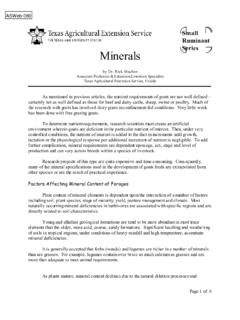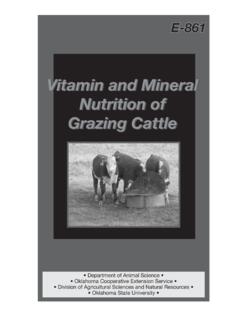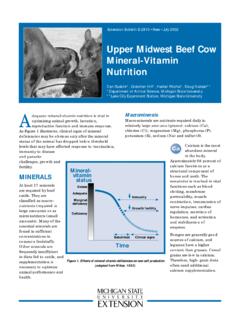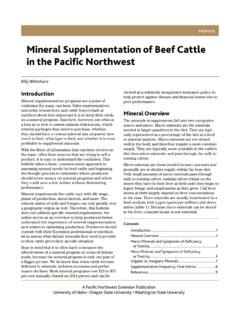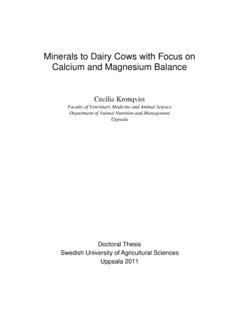Transcription of AS-1287 Beef Cattle - NDSU Libraries
1 1AS-1287 JUNE 2005 Marcy Ward, candidate,research associate,NDSU Department ofAnimal and Range SciencesGreg Lardy,NDSU Extension beef specialist,Department of Animal andRange SciencesMinerals make up a small portionof an animal s diet; however,they play an important role inhealth, growth and National Research Council(NRC 1984, 1996) has establishedmineral requirements for beef variables affect an animal smineral status, including soil andplant mineral compositions, climate,breed and stage of publication gives a briefoverview of minerals that havethe greatest impact on livestockproductivity. Requirements,deficiency and toxicity levels willbe provided with the intent thatthey be used as a management CattleMineralNutrition MacromineralsThis class of minerals is required inlarger amounts than trace minerals,and usually is expressed as a percent-age of the diet or grams per day,rather than parts per million (ppm).Calcium and PhosphorusAnimals calcium (Ca) requirementscannot be considered independentlyof phosphorus (P) since these twominerals work hand in and phosphorus are themajor mineral constituents of also plays an importantrole in muscle function, whereasphosphorus is key to major metabolicfunctions throughout the body(carbohydrate, protein and fatmetabolism, and nerve and musclefunction).
2 For example, when a bagof mineral supplement describesa 12:12 ratio on its feed label,it is referring to the Ca and Pconcentration in the supplement. Inthis example, the product ontains 12percent Ca and 12 percent P (Table 1).For grazing ruminants, Ca generallyis adequate in forages (especiallylegumes). Phosphorus, however,can be deficient in these forages,and since legumes containThis publication givesa brief overviewof mineralsthat have thegreatest impacton livestockproductivityhigher levels of Ca, supplementalphosphorus generally is neededin forage-based diets. When feedingor grazing legumes, provide amineral supplement that is higherin phosphorus than calcium to keepthe Ca:P ratio in a desired the Ca:P ratio exceeds 10:1, orphosphorus remains deficient,reduced growth, feed efficiencyand reproduction will result. Formore information about phosphorusrequirements, see the NDSUE xtension publication AS-1286, Phosphorus Supplementationand Requirements in Beef Cows.
3 For Cattle on a high-concentrate diet,the opposite problem exists. Mostcereal grains are much higher in Pthan Ca; therefore, Ca must be addedto the ration. When Ca:P approaches1:1, or P intake exceeds Ca, reducedfeed intake and urinary calculi (waterbelly) can result in steers and addition, if Ca is not supplementedin adequate amounts, Ca deficienciescan result. These deficiencies willnot become apparent, however, untilbroken bones, convulsions and deathoccur. Based on extensive research onthese two minerals, optimal perfor-mance occurs when the Ca:P ratio inbeef Cattle diets ranges from :1 to2 AS-1287 Beef Cattle mineral NutritionTable 1. Brand X mineral TagWill supplyPercentage of NRCNRCM ineralSpecificationsto total dietbRecommendationRecommendationcCalciu m, % , % , % , % , % , , ppm2, , , ppm5, , , ppm5, A, IU/lb300,00075, ,215,909vit D, IU/lb25,0006, ,438vit E, provided by the Missouri Ag Beef Focus Team, University of Missouri, to total diet based on 4 oz.
4 Intake per daycRequirements are estimated based on dietary and animal factors (age, sex, stage of production)from NRC 2000 Nutrient Requirements of Beef :1. However, performance typicallyis not adversely affected unless thedietary Ca:P ratio exceeds 6 (S) is unique in that it is theonly trace mineral incorporated intoamino acids (specifically, methionineand cystiene). Amino acids are thebuilding blocks for protein. Rumenmicroorganisms use inorganic sulfurto form their own sulfur-containingamino acids. Sulfur has many dietarysources. Soybean products, alfalfahay and corn byproducts haverelatively high levels of and biotin (vitamins), aswell as certain enzymes, also aresources of S. Water can contain highlevels of sulfur, as well. Cereal grains,such as corn or oats, generally rangefrom percent to percent S;protein sources, such as soybeanmeal, can contain as much as sulfur. Forages tend to bemore variable. Alfalfa, for example,typically will range between and percent S, whereasgrass hays, such as brome or prairie,contain little or no sulfur.
5 Cattle onpasture require percent S intheir in S are not , when a deficiency exists,signs include poor appetite,emaciation and dullness. In addition,low levels of dietary S can result inpoor utilization of nonprotein nitro-gen (NPN), which in turn reducesmicrobial growth and sulfur level is critical in growingand finishing rations. These diets,which typically are high in S andlow in fiber, can induce an S toxicity can interfere withselenium, copper, molybdenum andthiamin Dakota State University(Patterson, et al., 2003) recentlyreported data indicating intake andaverage daily gain decreased infeedlot Cattle as sulfate levels inwater increased. In addition, cattledeveloped a disease known aspolioencephalomalacia (PEM;commonly referred to as polio),when S levels in the water weregreater than 100 disease affects the nervoussystem. Symptoms include blindness,difficulty walking, muscle tremors,convulsions and ultimately concerned about sulfurshould have their water testedbefore they implement a sulfursupplementation and ChlorideSodium (Na) and chloride (Cl) worktogether to maintain cellular volume,pH and osmolarity (water balance)of body fluids, such as blood.
6 Sodiumchloride (NaCl) promotes waterintake, which will help maintain orimprove milk production and 3 Table 2. mineral requirements based on stage of production,maximum tolerable levels and the greatest impact onperformance in beef Cattle . aGrowing-GestatingLactatingFinishing Dry lbs1,250 lbs1,200 lbsTolerableImpactedCa, % , % , % , % , % , % , % , , , , , , Requirements based on values provided by NRC, 2000, and expressed in concentration(% or ppm).herd health. Individually, Cl isinvolved primarily in hydrochloricacid production in the abomasum(stomach) to aid in digestion. Sodiumworks in conjunction with potassium(K) for nutrient transport into andout of cells. On average, Cattle shouldconsume 11 to 15 grams of salt perday to meet nutritional elements can be consumed,and usually are, in relatively highamounts without negative effects,but dietary levels of NaCl shouldnot exceed 8 percent. Excess dietarysalt simply is excreted in the , salt often is usedas an intake limiter for self-fedsupplements.
7 However, keep in mindthat when salt is used to limit intake,it dilutes remaining nutrients in thefeed. Producers also run a risk ofoverfeeding toxicities do occur, symptomsinclude reduced milk productionand weight loss. Adequate wateravailability and intake can reduce therisk of toxicity. To reduce salt intake,use a salt block rather than a loosegranular supplement. Deficienciesin sodium can occur in forages thatare high in potassium (K) due tofertilization. Deficiency symptoms ofNa include reduced milk production,body condition, intake and requirements have not beendetermined fully. Since most foragesin the north-central region of theUnited States are low in sodiumand chloride, producers shoulduse a salt supplement (Table 2).PotassiumLike sodium (Na), Cattle needpotassium (K) in large amounts tomaintain normal body and organfunction. Potassium works inconjunction with Na in the bodyto transport nutrients in and out ofcells. It also helps maintain healthby maintaining the cellular waterbalance (osmotic pressure).
8 Increasedlevels of K in the animal s systemwill demand an equal increase inNa to maintain homeostasis in thebody s forages typically supplyadequate amounts of fact, K can be so high in somecool-season grasses and legumesthat it can accelerate the onset ofgrass tetany by inhibiting magnesium(Mg) absorption. In this case,producers need to providemagnesium high-concentrate diets, K levelsmay become deficient since corngrain and most corn byproducts arelow in K. Corn silage, however, is anexcellent source of K. Cattle percent to percent K in theration (DM basis). Most foragesources are relatively high in K(1 percent to 2 percent), whereascereal grains are lower ( percentto percent). Deficiencies in K canresult in reduced intake, weight lossand stiff joints. Cattle stressed dueto long shipping distances mayrequire increased levels of K toreplenish lost body have reported deficienciesin K in grazing situations during thewinter months, particularly for cattlegrazing cool-season grass can leach out of the plantsduring dormancy.
9 A mineral supple-ment containing at least 1 percent Kcan remedy deficiencies easily. Trace MineralsThis class of minerals is required invery small amounts. Requirementstypically are expressed in feed inparts per million (ppm), or milli-grams per kilogram body weight(mg/kg), both of which are concen-tration units. Although these mineralsare required in small amounts, theystill play important roles in normalbody function (Table 2).4 AS-1287 Beef Cattle mineral NutritionProducers need to pay attentionto dietary levels and the animal s requirementsto meet their herd s needs cost s (Co) primary function inthe ruminant animal is to providea substrate for the rumen microbesto produce vitamin B12. Vitamin B12is used in the rumen microbes metabolic processes to produceproprionate (a volatile fatty acid andan important energy source for theanimal). When present in the largeintestine, Co also can be a substitutefor Zn in the production of specificprotein-degrading the animal doesn t absorbCo readily, the involvement of Co invitamin B12 production makes it animportant of Co are far morecommon than toxicities, as Cattle cantolerate up to 300 times their require-ment ( ppm).
10 When deficienciesoccur, signs include depressedappetite, listlessness, decreasedgrowth, reduced milk productionand rough hair coat. Fortunately,Co typically is adequate in summerrange forages and many , including this mineral infeeding programs, particularly whenfeeding dry forage, provides addedinsurance with little risk. Cobaltis found in most trace mineralsupplements. The feed tag may notlist its inclusion rate, but Co shouldbe listed under the ingredient portionof the tag (Table 1).Copper and MolybdenumRed-blood cell health, collagendevelopment, reproduction andimmunity are just a few of theimportant roles of copper (Cu).Copper also works in conjunctionwith molybdenum (Mo) andinorganic sulfur to create severalimportant enzymes involved innucleotide and vitamin , a balance betweenCu and Mo is important. A ratio of2:1 to 4:1 (Cu:Mo) allows for optimalperformance in grazing soils contain ppm Mo, which is adequatein meeting the animal s a soil is alkaline (> , pH) oris high in Ca (> percent), Cuavailability is reduced.

